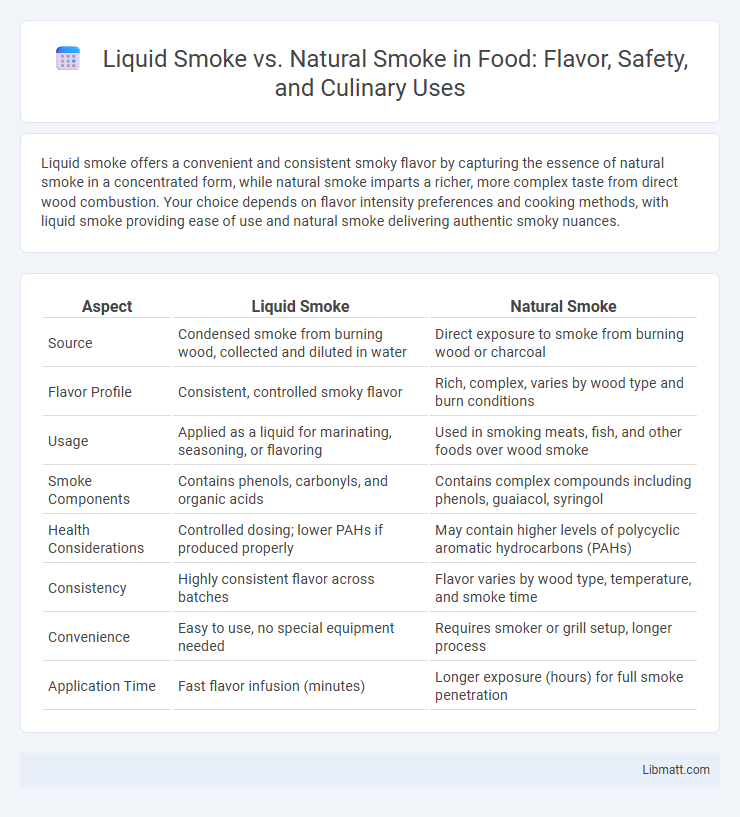Liquid smoke offers a convenient and consistent smoky flavor by capturing the essence of natural smoke in a concentrated form, while natural smoke imparts a richer, more complex taste from direct wood combustion. Your choice depends on flavor intensity preferences and cooking methods, with liquid smoke providing ease of use and natural smoke delivering authentic smoky nuances.
Table of Comparison
| Aspect | Liquid Smoke | Natural Smoke |
|---|---|---|
| Source | Condensed smoke from burning wood, collected and diluted in water | Direct exposure to smoke from burning wood or charcoal |
| Flavor Profile | Consistent, controlled smoky flavor | Rich, complex, varies by wood type and burn conditions |
| Usage | Applied as a liquid for marinating, seasoning, or flavoring | Used in smoking meats, fish, and other foods over wood smoke |
| Smoke Components | Contains phenols, carbonyls, and organic acids | Contains complex compounds including phenols, guaiacol, syringol |
| Health Considerations | Controlled dosing; lower PAHs if produced properly | May contain higher levels of polycyclic aromatic hydrocarbons (PAHs) |
| Consistency | Highly consistent flavor across batches | Flavor varies by wood type, temperature, and smoke time |
| Convenience | Easy to use, no special equipment needed | Requires smoker or grill setup, longer process |
| Application Time | Fast flavor infusion (minutes) | Longer exposure (hours) for full smoke penetration |
Introduction: Liquid Smoke vs Natural Smoke
Liquid smoke is a condensate derived from wood smoke, designed to impart smoky flavor quickly and consistently in foods, whereas natural smoke results directly from the combustion of wood, infusing complex aromas and compounds during cooking. Liquid smoke contains concentrated phenols and carbonyls that mimic traditional smoke flavor but can lack some depth of natural smoke's diverse volatile compounds. Natural smoke offers unique flavor nuances influenced by wood type, combustion temperature, and exposure time, crucial for authentic smoked meats and barbecue.
What is Liquid Smoke?
Liquid smoke is a concentrated flavoring derived from condensing smoke produced during the combustion of wood, capturing the essence of natural smoke without the need for direct smoking. This product is commonly used to impart smoky flavor to foods quickly and efficiently, enhancing your recipes with authentic smoky notes. Unlike natural smoke, which requires exposure to smoke over time, liquid smoke offers a convenient alternative that preserves flavor while reducing preparation time.
What is Natural Smoke?
Natural smoke is produced by burning wood or plant materials, releasing aromatic compounds that infuse food with distinctive smoky flavors. Unlike liquid smoke, which is a concentrated condensate derived from natural smoke, natural smoke contains a broader spectrum of complex chemicals generated during the combustion process. Your cooking benefits from natural smoke's authentic taste and aroma, which many chefs prefer for traditional smoking methods.
How Liquid Smoke is Produced
Liquid smoke is produced by capturing the smoke generated from burning wood chips or sawdust through a controlled pyrolysis process, where the smoke is cooled and condensed into a liquid form. This liquid contains the essential flavor compounds such as phenols, carbonyls, and organic acids that give food a smoky taste. Unlike natural smoke, which results from direct contact with burning wood, liquid smoke offers a more consistent, convenient, and easily measurable way to apply smoky flavor to food.
How Natural Smoke is Generated
Natural smoke is generated through the combustion or smoldering of wood, where the heat causes pyrolysis, releasing complex organic compounds such as phenols, carbonyls, and acids that contribute to flavor and aroma. This smoke contains a diverse mixture of volatile molecules and particulate matter that interact with the food surface, imparting a distinct smoky character. The specific wood type and combustion conditions influence the chemical composition and intensity of the natural smoke produced.
Flavor Differences: Liquid vs Natural Smoke
Liquid smoke offers a concentrated, consistent smoky flavor derived from condensed smoke vapor, making it easy to control in recipes. Natural smoke imparts a richer, more complex taste influenced by wood type, combustion temperature, and exposure time, resulting in unique, authentic smoky nuances. You can enhance your dishes by choosing liquid smoke for convenience or natural smoke for traditional depth of flavor.
Health and Safety Considerations
Liquid smoke is often favored for its consistent flavor and reduced carcinogens compared to natural smoke, which contains higher levels of polycyclic aromatic hydrocarbons (PAHs) linked to cancer risks. Natural smoking involves direct exposure to combustion byproducts that can pose respiratory hazards and increase the formation of harmful compounds on food. You should consider that liquid smoke offers a safer alternative by providing smoky flavor without the intense exposure to toxic substances inherent in traditional smoking methods.
Culinary Uses: Applications of Both Smokes
Liquid smoke offers precise control for infusing smoky flavor in marinades, sauces, and processed foods, making it ideal for consistent taste in home cooking and commercial production. Natural smoke, produced by burning wood, imparts rich, complex aromas and is commonly used in traditional barbecue, smoking meats, and curing cheeses for authentic smoky profiles. You can leverage liquid smoke for quick seasoning, while natural smoke enhances flavor depth through slow cooking techniques.
Environmental Impact Comparison
Liquid smoke production generates fewer air pollutants and requires less wood than traditional natural smoke methods, resulting in a lower carbon footprint. Natural smoking involves direct combustion of hardwoods, releasing higher levels of particulate matter and greenhouse gases into the atmosphere. Opting for liquid smoke can reduce your environmental impact by conserving forests and minimizing harmful emissions associated with natural smoking techniques.
Which One Should You Choose?
Choosing between liquid smoke and natural smoke depends on your culinary goals and convenience preferences. Liquid smoke offers consistent flavor, ease of use, and faster application, making it ideal for everyday cooking and recipes requiring precise smoky notes. Natural smoke, derived from wood-burning processes, provides a more complex, authentic smoky aroma and taste preferred by barbecue enthusiasts seeking traditional smokehouse flavors.
liquid smoke vs natural smoke Infographic

 libmatt.com
libmatt.com